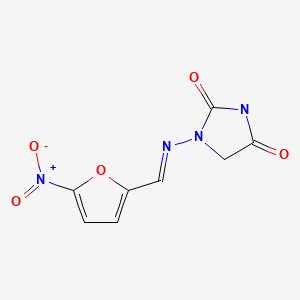Attribution Statement: LactMed is a registered trademark of the U.S. Department of Health and Human Services.
NCBI Bookshelf. A service of the National Library of Medicine, National Institutes of Health.
Drugs and Lactation Database (LactMed®) [Internet]. Bethesda (MD): National Institute of Child Health and Human Development; 2006-.
CASRN: 67-20-9

Drug Levels and Effects
Summary of Use during Lactation
Administration of nitrofurantoin directly to infants under 1 month of age and in those with glucose-6-phosphate dehydrogenase (G6PD) deficiency is contraindicated because of potential hemolysis in these infants. However, the time of greatest risk for hemolysis in fullterm newborns without G6PD deficiency might be as short as 8 days after birth.[1] Nitrofurantoin doses in milk are low and it can be used while breastfeeding older infants, but alternate drugs are preferred in mothers of infants under 8 days of age, or infants with G6PD deficiency of any age. Observe infants for possible diarrhea.
Drug Levels
The time of the peak amounts in milk depends on the food taken with the drug and the dosage form of the drug. Rapid-release capsules of nitrofurantoin macrocrystals reach their peak milk levels either 1 to 2 hours after the dose with food or 4 hours after a high-fat meal. The sustained-release product (Macrobid) has not been studied, but probably has a delayed peak milk time that would be difficult to predict in an individual mother.
Maternal Levels. In one early report, random samples of milk from several women in the first few days postpartum who were receiving 100 mg orally 4 times daily were tested for nitrofurantoin. Nitrofurantoin was undetectable (<2 mg/L) in 20 samples measured.[2]
A second study found milk levels ranging from 0 to 0.5 mg/L in 4 women (time postpartum not stated) 2 hours after a single dose of 200 mg of nitrofurantoin was given orally during therapy with 100 mg 4 times a day. In 5 others receiving 100 mg orally 4 times daily, no drug was detected in milk levels (assay limit not stated).[3]
Six women who were 3 to 6 days postpartum were given 50 or 100 mg of nitrofurantoin macrocrystals orally 3 times a day. Nitrofurantoin was undetectable (<10 mcg/L) in all women before the first dose of the second day of administration with breakfast (fat content not stated). Peak milk levels occurred 1 to 2 hours after the dose. Mothers taking the 50 mg dose had an average of 0.49 mg/L (range 0.2 to 0.7 mg/L) in milk 3 hours after the dose and those given 100 mg had milk levels of 1.19 mg/L (range 0.62 to 2.22 mg/L) in milk at 3 hours. The authors calculated that between 0.06 and 0.28% of a dose was excreted into milk during the 6 hours after a dose.[4]
Four women who were 8 to 26 weeks postpartum received a single 100 mg dose of nitrofurantoin macrocrystals orally with a high-fat meal. Under these conditions, peak milk levels occurred 4 to 6 hours after the dose. Peak levels averaged 2.7 mg/L (range 2.2 to 3.2 mg/L). Milk levels were higher than serum levels and much higher than predicted at all times, indicating active transport into milk. Nevertheless, an exclusively breastfed infant would receive only 0.2 mg/kg daily or about 6% of the weight-adjusted maternal dosage.[5]
Infant Levels. Relevant published information was not found as of the revision date.
Effects in Breastfed Infants
In a prospective follow-up study, 6 nursing mothers reported taking nitrofurantoin (dosage and dosage form not specified). Two mothers reported diarrhea in their infants. No rashes or candidiasis were reported among the exposed infants.[6]
Effects on Lactation and Breastmilk
In a prospective follow-up study, 1 of 6 nursing mothers who took nitrofurantoin (dosage unspecified) reported a decrease in milk supply.[6] It is not known if there was a causal relationship.
Alternate Drugs to Consider
References
- 1.
- Zao J, Koren G, Bozzo P. Using nitrofurantoin while breastfeeding a newborn. Can Fam Physician 2014;60:539-40 [PMC free article: PMC4055319] [PubMed: 24925943]
- 2.
- Hosbach RE, Foster RB. Absence of nitrofurantoin from human milk. JAMA 1967;202:1057 [PubMed: 6072610]
- 3.
- Varsano I, Fischl J, Shochet SB. The excretion of orally ingested nitrofurantoin in human milk. J Pediatr 1973;82:886-7 [PubMed: 4735457]
- 4.
- Pons G, Rey E, Richard MO, et al. Nitrofurantoin excretion in human milk. Dev Pharmacol Ther 1990;14:148-52 [PubMed: 2364853]
- 5.
- Gerk PM, Kuhn RJ, Desai NS, et al. Active transport of nitrofurantoin into human milk. Pharmacotherapy 2001;21:669-75 [PubMed: 11401180]
- 6.
- Ito S, Blajchman A, Stephenson M, et al. Prospective follow-up of adverse reactions in breast-fed infants exposed to maternal medication. Am J Obstet Gynecol 1993;168:1393-9 [PubMed: 8498418]
Substance Identification
Substance Name
Nitrofurantoin
CAS Registry Number
67-20-9
Drug Class
Breast Feeding
Lactation
Milk, Human
Anti-Infective Agents, Urinary
Antibacterial Agents
Nitrofurans
Disclaimer: Information presented in this database is not meant as a substitute for professional judgment. You should consult your healthcare provider for breastfeeding advice related to your particular situation. The U.S. government does not warrant or assume any liability or responsibility for the accuracy or completeness of the information on this Site.
- User and Medical Advice Disclaimer
- Drugs and Lactation Database (LactMed) - Record Format
- LactMed - Database Creation and Peer Review Process
- Fact Sheet. Drugs and Lactation Database (LactMed)
- Drugs and Lactation Database (LactMed) - Glossary
- LactMed Selected References
- Drugs and Lactation Database (LactMed) - About Dietary Supplements
- Breastfeeding Links
- PMCPubMed Central citations
- PubChem SubstanceRelated PubChem Substances
- PubMedLinks to PubMed
- Nitrofurantoin - Drugs and Lactation Database (LactMed®)Nitrofurantoin - Drugs and Lactation Database (LactMed®)
- TSA: Pan troglodytes Chimpanzee_0126593 mRNA sequenceTSA: Pan troglodytes Chimpanzee_0126593 mRNA sequencegi|410336538|gb|GABE01007523.1||gnl GABE01|Chimpanzee_0126593Nucleotide
- NF-X-like 1 isoform 1 [Theobroma cacao]NF-X-like 1 isoform 1 [Theobroma cacao]gi|508710702|gb|EOY02599.1||gnl|WGS |Thecc1EG017029p1Protein
- RNF38 ring finger protein 38 [Homo sapiens]RNF38 ring finger protein 38 [Homo sapiens]Gene ID:152006Gene
- 152006[uid] AND (alive[prop]) (1)Gene
Your browsing activity is empty.
Activity recording is turned off.
See more...
